The Landscapes of the Highlands of Chiang Rai, Keng Tung and Jing hong: The Relation among the People, Economic and Religion
Main Article Content
Abstract
Abstract
This research was aimed to find out the relation among the Buddhist landscapes on the highland areas and the mountains where “Phra Tat”(Buddha Relics) were existing , the people and their economies in Chiang Rai of Thailand, in Keng Tung of Republic of Union of Myanmar and in Jinghong of People’s Republic of China (PRC). The research methodology used were the integration of ancient document study, field work investigation and the study of geographic information system. It was found that the classification of “Phra Tat” on the mountains could be classified into 5 groups as the following 1) the cliff shelter and the standing stone 2) the triangle mountains 3) the mountain at the middle of the town or called “Pu Kao Mai Muang” 4. the small hills and 5) the cluster of small hills in the valley. Information obtained from the study could be explained the relation among them as the following.
Buddhism was a mechanism using to establish civilization and economic prosperity in the highland area by encouraging the literacy of the people and the moral of trade. Religion made various and different ethnic groups of people to be as a unity in the distance trade according to the discovery of “Phra Tat” on the sacred mountains along the trade routes. At the location of “Phra Tat”, the “Hua Kham” was found. It showed that religion was related to the power of the state. When establishing the city, it was composted of cultural landscape of triangle mountains which located at the area of the capillary water which it made Buddhism adjust and change itself all the time by being always ready to move Buddhist sites and monks to prosperous area.
This research was the case to be compared and discussed to the case study by Leach E.(1954) “the Political Systems of Highland, Burma”. It was an illustration the case of Plang ethnic group who lived at the highland, believed in Buddhism,studied Tai language for trading business and had a knowledge of “Aksorn Dhama” which was a religious character. They still maintained their Plang ethnic identity even when they were working at the plain areas and having long relationship with the people at those places. They had never became Tai Khun or Tai Yai or Tai Lue and they were still keeping these highlands for making themselves prosperity and brought in resources from there to establish their own religious spaces.
Article Details
References
Hiranro, C., Mahama, A., Prapattong, P.. 2017. Cultural Spaces Based on the Comparison of Chicken Bone Divination Scripts from Three Villages. Proceeding in The 10th International Conference of HUSOC Network on “Dynamics of Humanities and Social Sciences in Cross-Border Societies” was held on February 2nd – 3rd, 2017. Main Auditorium at Chiang Rai Rajabhat University.
Leach, Edmund R. [1954] 1964. Political Systems of Highland Burma: A Study of Kachin Social Structure. London, England: G. Bell and Sons
Rao Rui-ying (2563). พุทธศาสนาในล้านนาและสิบสองปันนา ความสัมพันธ์และความเปลี่ยนแปลง. บรรยายในงานประชุมวิชาการเรื่องล้านนาข้าพรมแดน ณ สถาบันวิจัยสังคมมหาวิทยาลัยเชียงใหม่. วันที่ 13 มีนาคม 2563
THE WORLD BANK. (ม.ป.ป.). International tourism, number of arrivals – China 1995-2018. สืบค้นเมื่อวันที่ 10 มีนาคม 2563. จาก https://data.worldbank.org/indicator/ST.INT.ARVL?end=2018&locations=CN&start=1995&view=chart
คงเดช ประพัฒน์ทอง.(2508). พระธาตุเจดีย์ในเมืองเชียงแสน. สืบค้น 31 มกราคม 2563, จากhttp://museum.mfu.ac.th/download-pdf/article.htm
ทิวทัศน์ต้องห้าม ในรัฐฉาน. (2552). เชียงใหม่: เครือข่ายปฏิบัติงานผู้หญิงไทใหญ่ (SWAN).
เธียรชาย อักษรดิษฐ์. (2552). ตำนานพระเจ้าเลียบโลก : การศึกษาพื้นที่ทางสังคมและวัฒนธรรมล้านนา ภูมินาม ตำนาน ผู้คน. เชียงใหม่: ธารปัญญา.
บุญช่วย ศรีสวัสดิ์. (2557). ไทยสิบสองปันนา. พิมพ์ครั้งที่ 3. กรุงเทพฯ: ศยาม.
ปฐม หงส์สุวรรณ. (2548). ตำนานพระธาตุของชนชาติไท: ความสำคัญและปฏิสัมพันธ์ระหว่างพุทธศาสนากับความเชื่อดั้งเดิม. กรุงเทพฯ: บัณฑิตวิทยาลัย จุฬาลงกรณ์มหาวิทยาลัย.
พลวัฒ ประพัฒน์อง และคณะ. (2558). บันทึกการเดินทางบนเส้นทางวงแหวนอารยธรรมลุ่มน้ำโขงตอนบน เชียงตุงเมืองลา สามต้าว. เชียงใหม่: เอราวันการพิมพ์.
วราภรณ์ เรืองศรี. (2556). การค้าชายแดน และการปรับเปลี่ยนรูปแบบของรัฐบริเวณตอนในของ เอเชียตะวันออกเฉียงใต้ภาคพื้นทวีป ระหว่างคริสต์ศตวรรษที่ 19 ถึงต้นคริสต์ศตวรรษที่ 20 (วิทยานิพนธ์ปริญญาอักษรศาสตรดุษฎีบัณฑิต). กรุงเทพฯ: จุฬาลงกรณ์มหาวิทยาลัย.
ศุภนารถ เกตุเจริญ และอัญชลี พัดมีเทศ. (ม.ป.ป.). ชา. สืบค้น 31 มกราคม 2563, จาก http://eto.ku.ac.th/neweto/e-book/plant/tree_fruit/fruit17.pdf
สันติ เล็กสุขุม. (2552). เจดีย์ ความเป็นมาและคำศัพท์เรียกองค์ประกอบเจดีย์ในประเทศไทย. พิมพ์ครั้งที่ 5. กรุงเทพฯ: มติชน.
สุดแดน วิสุทธิลักษณ์ และ วัลลภ ทองอ่อน. (2559). รูปแบบทางพื้นที่ของตำนานพระเจ้าเลียบโลก: บทวิเคราะห์ตำนานด้วยระบบสารสนเทศภูมิศาสตร์. วารสารสังคมวิทยามานุษยวิทยา. 35 (2): 29-43.
เสมอชัย พูลสุวรรณ. (2559). เถรวาทในเอเชียอาคเนย์. วารสารสังคมวิทยามานุษยวิทยา. 35 (2): 1-19.

